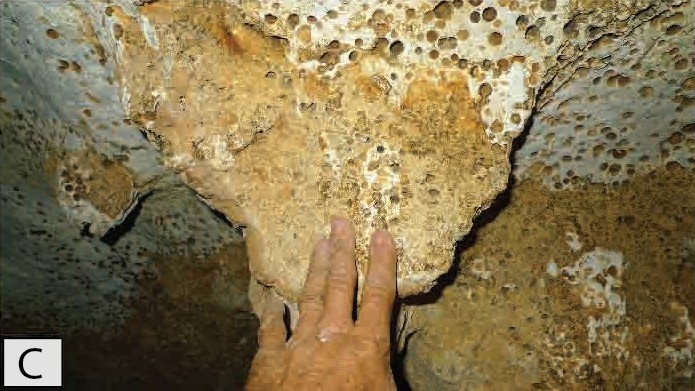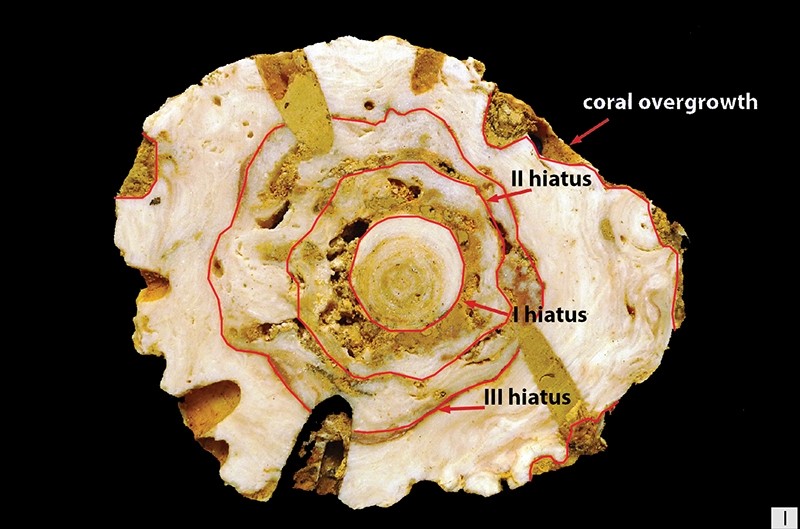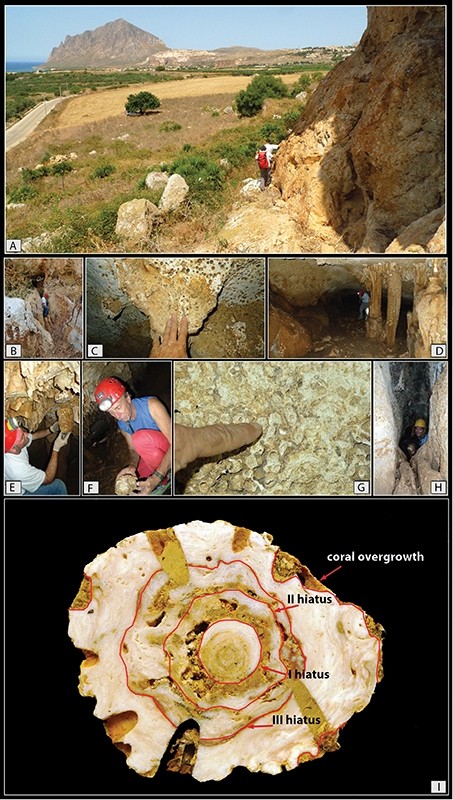De Antarctische ijskap verloor 1,2 miljoen jaar geleden een derde van zijn massa
De resultaten uit dit onderzoek wijzen op de instabiliteit van de Antarctische ijskap tijdens perioden tussen twee ijstijden in (interglaciale perioden). Het levert sterke nieuwe feiten op die bijdragen aan de lopende discussie over in welke mate smeltend Zuidpoolijs bijdraagt aan de stijging van de zeespiegel als gevolg van klimaatverandering. "Dit nieuwe resultaat laat opnieuw zien dat de Antarctische ijskap behoorlijk instabiel is en zeker in staat is om enorme massa’s gesmolten ijs los te laten”, zegt NIOZ hoofdonderzoeker Dr. Paolo Stocchi. "Het reconstrueren van het geologische verleden helpt ons om de mate en de snelheid van de processen beter te begrijpen die reageren op smeltend ijs als gevolg van opwarming van de aarde. Hierdoor kunnen we beter voorspellen wat er in de toekomst gebeurt en zo de best mogelijke beschermings- en beleidsmaatregelen nemen."
Het was een stalactiet in een druipsteengrot die de onderzoekers leidde naar nieuwe informatie over variaties in de hoogte van de zeespiegel in het Midden-Pleistoceen. Deze “Custonaci stalactiet” werd gevonden in een kalkgrot in Noord-West-Sicilië in Italië en verschafte de onderzoekers bewijs voor vier grote overstromingen in dit geologische tijdvak. Tijdens de laatste overstroming heeft zich koraal afgezet op de stalactiet. De leeftijd van de koralen op de Custonaci stalactiet wordt geschat op 1.123 miljoen jaar (gebaseerd op Uranium / Thorium verhoudingen en Strontium 87/86 isotoop verhoudingen). Daarmee is de Custonaci stalactiet de oudste druipsteen met onderbrekingen die duiden op grote overstromingen in het Midden-Pleistoceen.

Custonaci stalactiet
Druipsteengrotten aan zee zijn interessante plekken voor geologen. Aan de hand van de druipstenen kunnen zij een reconstructie maken van veranderingen in de zeespiegelhoogte in het verre verleden. Wanneer een stalactiet aan lucht wordt blootgesteld groeit hij als gevolg van kalkafzetting, maar wanneer hij voor langere tijd onderwater komt te staan door zeespiegelstijging lost hij weer op. Een doorsnede van de Custonaci-stalactiet onthult concentrische ringen die wijzen op kalkoplossing door tijdelijke overstromingen van de grot. Om een verband te leggen tussen de vier overstromingen en de daadwerkelijke zeespiegelhoogte, moesten de wetenschappers eerst reconstrueren hoe snel de grot omhoog is gekomen door tektonische opheffing. Die resultaten vergeleken zij vervolgens met de modeluitkomsten van variaties in zeespiegelhoogtes uit die tijd.

Resultaten & relevantie voor de toekomst
Het Mariene Isotoop Stadium (MIS) 35 van het Midden-Pleistoceen wordt door de onderzoekers gekarakteriseerd als de laatste (4e) overstroming waarin de koralen zich aan de buitenzijde van de stalactiet hebben gehecht. De koraalsoorten die op de stalactiet teruggevonden zijn, groeien in grotten op een diepte van 20-30 meter. Op dat moment bevond de grot zich nog op een hoogte van enkele meters boven de huidige zeespiegel (sindsdien is hij ongeveer 100 meter naar boven gedrukt door tektonische opheffing). Geologen weten dat tijdens MIS 35 ook een grote hoeveelheid van het landijs van de Antarctische ijskap is gesmolten. Op basis van de berekeningen in het artikel moet 30 tot 40 procent van de ijskap smelten om een zeespiegelstijging van 20 tot 30 meter te veroorzaken in de Middellandse Zee. Dit betekent dat in het Midden-Pleisoceen niet alleen het onstabielste westelijke deel van de Antarctische ijskap is gesmolten, maar ook een deel van het veel stabieler geachte oostelijke deel.
De huidige ijsmodellen berekenen echter een zeespiegelstijging van slechts 10 meter onder deze klimaatcondities. Dit modelresultaat kan wel verklaard worden door gesmolten ijs van uitsluitend West-Antarctica. De reden voor deze grote modelonderschatting is waarschijnlijk dat de tektonische opheffing in deze modellen onvoldoende is opgenomen. De ijsmodellen gebruikt in deze studie zijn ontwikkeld door Dr. Bas De Boer van het Instituut voor Marien en Atmosferisch Onderzoek (IMAU) aan de Universiteit Utrecht. De Boer: "Voor de simulaties met de ijsmodellen maken we gebruik van een wereldgemiddelde klimaatverandering. Met een betere representatie van hoe temperatuur en neerslag verandert boven de ijskappen, hopen we in de toekomst de zeespiegelstijgingen beter te kunnen simuleren en begrijpen."
Publicatie:
Stocchi, P .; Antonioli, F .; Montagna, P .; Pepe, F .; Lo Presti, V .; Caruso, A .; Corradino, M .; Dardanelli, G .; Renda, P .; Frank, N .; Douville, E .; Thil, F .; De Boer, B .; Ruggieri, R .; Sciortino, R .; Pierre, C. (2017). Een stalactietrecord van vier relatieve zeespiegelhoogtes tijdens de Middle Pleistocene Transition. Quat. Sci. Openb. 173: 92-100. https://dx.doi.org/10.1016/j.quascirev.2017.08.008
~ English version below ~
The Antarctic icecap lost one-third of its mass 1.2 million years ago
The Antarctic ice sheet is capable of losing up to one-third of its mass during warm interglacials. An international team of scientists, led by NIOZ Royal Netherlands Institute for Sea Research found evidence for a sea-level highstand 1.2 million years ago which is three times higher than calculated in the current ice sheet models. The results have just been published in the journal ‘Quaternary Science Review’.
The findings of this research point at the Antarctic Ice Sheet instability during interglacial periods. It provides a further strong case in the on-going discussions about the degree of Antarctic Ice Sheet contribution to global sea-level change in response to a warmer climate that we should prepare for. “This new finding shows once more that Antarctica is unstable and definitely prone to release huge amounts of water during warm interglacials”, says NIOZ scientist Dr. Paolo Stocchi. “Reconstructing events in the geological past help us to understand the physical processes that regulate the response of ice sheets to climate change and, most importantly, all the uncertainties. We can therefore improve to forecast the future.”
It was a stalactite that led to new information about the sea-level stand in the Middle Pleistocene Transition, a geological time 1.2 million years ago where very little is known about. The Custonaci stalactite, found in a karst cave in North West Sicily in Italy, provided the scientists with evidence of four marine inundations that correspond to this time. The measured age of the corals on the Custonaci stalactite was 1.123 million years (based on Uranium/Thorium ratios and Strontium 87/86 isotopic ratios), which makes it the oldest known speleothem containing marine hiatuses.

Custonaci stalactite
Geomorphological features such as stalactites that are found in karst caves connected to the sea, are commonly used to reconstruct past sea-level changes. The stalactites grow as a result of calcite deposition when they are exposed to air. However, their growth is interrupted during marine flooding events caused by sea-level rise and which result in dissolution and erosion of the stalactite. A cross-section of the Custonaci stalactite reveals three concentric rings, or hiatuses, that can be converted into sea-level changes when the height of the stalactite with respect to mean sea level is known. To correlate the four observed hiatuses with the corresponding sea levels, the authors have first reconstructed the long-term elevation of the cave based on geological evidences for tectonic uplift. Then they intersected the cave with reconstructed sea-level curves based on independent deep-sea sedimentary data as well as predicted sea-level curves based on numerical ice-sheet models.

Results and relevance for the future
The authors identified the Marine Isotope Stage (MIS) 35 in the Mid-Pleistocene as the last flooding event during which the corals attached themselves to the stalactite. The coral species that have been identified on the Custonaci stalactite can grow in marine caves at depths of 20-30m. At that time, the cave was at a height of few meters above present-day sea level (and has been uplifted by about 100 m since then). Therefore, a significant melting of continental ice from Antarctica, occurred during MIS 35. Of the current Antarctic ice-sheet, and based on most recent estimates, 30 to 40 percent would need to melt to cause such a sea-level rise of 20 to 30m in the Mediterranean. This would imply that not only the more unstable West-Antarctic ice sheet melted, but also part of the East-Antarctic ice-sheet.
However, the ice-sheet models used only estimated a less than 10m rise in local sea-level, coming from West Antarctica only. The reason for such an underestimation is likely to be found in the incorrect forcing that is used as input in the models to simulate ice-sheets fluctuation. Thus, for this study Utrecht University researcher Dr. Bas de Boer (IMAU, Institute for Marine and Atmospheric Research), designed a new ice-sheet model. De Boer: "For the simulations with the ice-sheet models, we used the mean figures of global climate change. With a better representation of how temperature and precipitation change over the ice caps, we hope to be able to simulate and understand sea level increases in the future."
Publication:
Stocchi, P.; Antonioli, F.; Montagna, P.; Pepe, F.; Lo Presti, V.; Caruso, A.; Corradino, M.; Dardanelli, G.; Renda, P.; Frank, N.; Douville, E.; Thil, F.; de Boer, B.; Ruggieri, R.; Sciortino, R.; Pierre, C. (2017). A stalactite record of four relative sea-level highstands during the Middle Pleistocene Transition. Quat. Sci. Rev. 173: 92-100. https://dx.doi.org/10.1016/j.quascirev.2017.08.008
